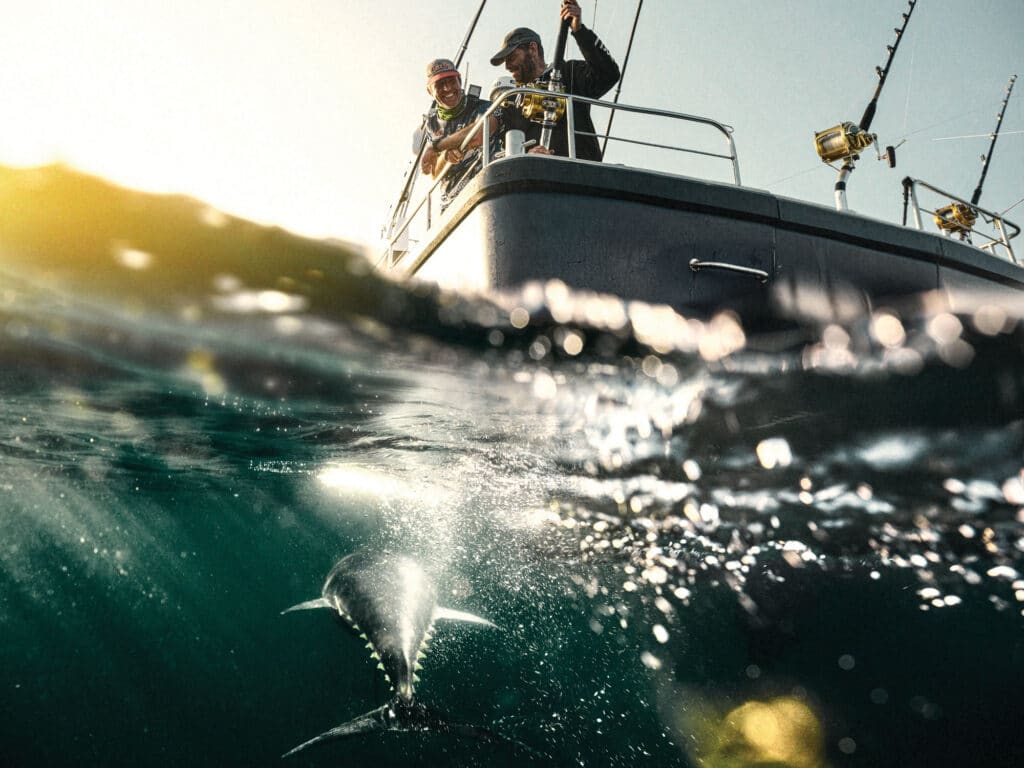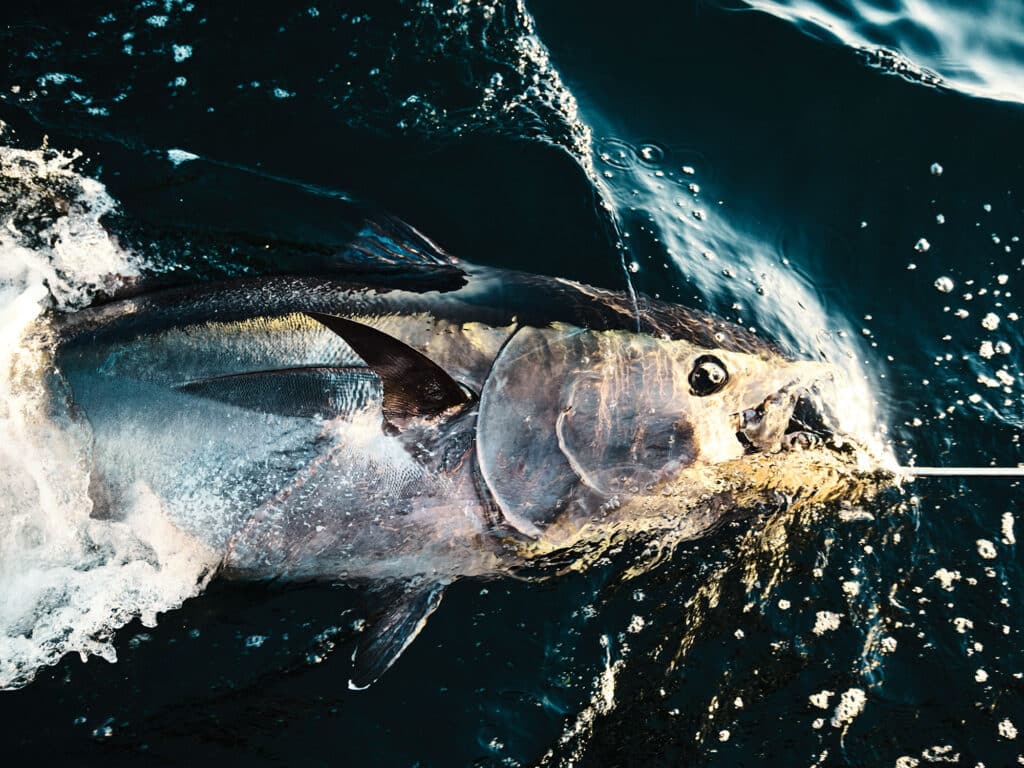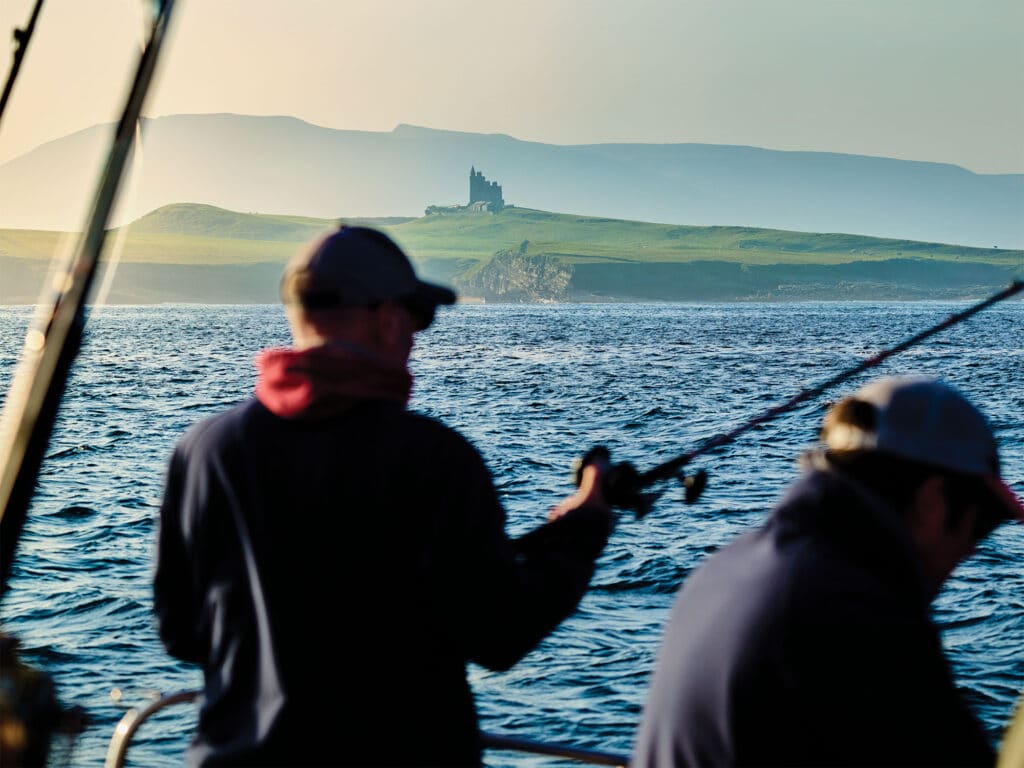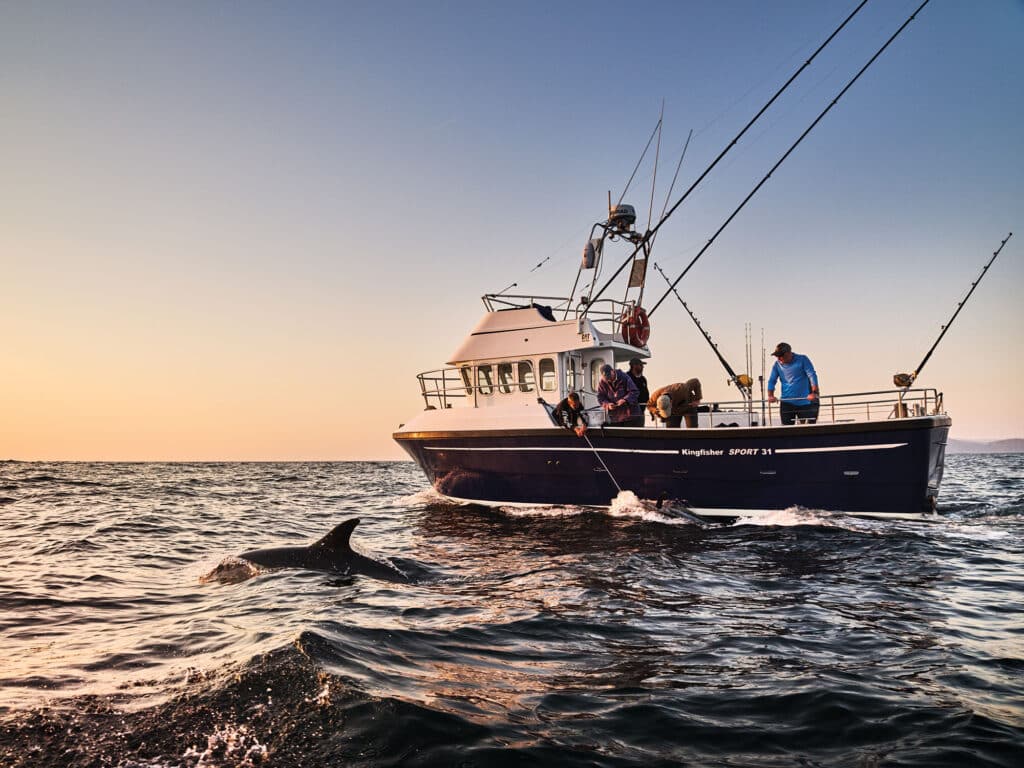The Bluefin Tuna of Donegal Bay
 With the peak summer season in September, captains experience good success rates that average about 1.5 big bluefins per trip.
Benjamin Etridge
With the peak summer season in September, captains experience good success rates that average about 1.5 big bluefins per trip.
Benjamin Etridge
Off the shores of Mullaghmore on the northwest Irish coast, between the green hills of Benbulben and the cliffs of Slieve League, stretches Donegal Bay, whose blue-green waters come alive in summer with giant bluefins strafing through schools of sprat, needle-eye and mackerel. Pursuing those behemoths under such hospitable circumstances—in sight of scenic hills and towns with restaurants and bars not far from the docks—feels like a rare privilege in sport, and it is, especially considering that only 10 years ago, Atlantic bluefin was scarce and its stocks considered in danger.
Most of Donegal Bay’s bluefins are of the eastern stock, spawned in the Mediterranean. They mix with western Atlantic bluefin across the North Atlantic. Both stocks use the Gulf Stream as a guide in their migrations. On its eastward trajectory across the North Atlantic, the Gulf Stream breaks into a branch current called the North Atlantic Drift, which flows with bluefin and warm waters to the west of Ireland and Donegal Bay. Add it to the short list of the world’s big bluefin destinations.
Last September, I fished Donegal Bay for bluefin for three days with Capt. Declan Kilgannon and mate Matt McKeown on Kiwi Girl out of Mullaghmore. September is the peak of the summer season, though the bluefins show in July and stay through December.
 Ireland’s recreational catch-and-release season was sanctioned in 2019. Last year, 22 captains were authorized to tag and release bluefins.
Benjamin Etridge
In the Blue-Green of Donegal Bay
Ireland’s recreational catch-and-release season was sanctioned in 2019. Last year, 22 captains were authorized to tag and release bluefins.
Benjamin Etridge
In the Blue-Green of Donegal Bay
Capt. Declan Kilgannon grew up in nearby Sligo, visible just over the hills from Donegal Bay. He started as a diver and knows the bay’s patterns over the days, the seasons and the years.
“Usually, we’ll find the bluefin out here from the 50-meter contour deeper,” Kilgannon said aboard Kiwi Girl on our second day out. It’s a 30-minute ride from the dock in Mullaghmore to the 50-meter contour, and it’s only 18 miles farther to the mouth of the bay.
Donegal Bay has depths of 300 feet and stretches about 25 miles across. Along with bluefin, it holds a rich fishery for table fish, including mackerel, pollack, ling, coalfish and some cod. The bay is a nursery for sprat (a small member of the herring family), mackerel, herring, and other forage fish. It is also feeding ground for many fish and mammals. Its late-summer water temperatures are about 15 degrees C (low 50s F, but not quite warm enough for yellowfin).
“We have a number of fish in the 200-pound range,” Declan says, “but also many fish up to 600 pounds and more, and we have no way of targeting which size we’ll catch, so we tend to start out the day with the bigger gear, the 130s, but we have the potential on board to scale down with both a chair and stand-up gear. Fighting out of the rod holder gives the fish a better chance by getting them in fast. It’s generally 20 minutes, 30 minutes to get a big fish. The chair is fine in good weather.”
 With the green hills of the northern Irish coast as a backdrop, anglers pursue large tuna, some that weigh 600 pounds or more.
Benjamin Etridge
With the green hills of the northern Irish coast as a backdrop, anglers pursue large tuna, some that weigh 600 pounds or more.
Benjamin Etridge
Kilgannon and McKeown troll lures behind spreader bars or drift live mackerel on circle hooks. On board, we scout for telltale sights: shearwaters, kitty wakes, plovers flitting over feeding dolphins and sometimes whales—fin, humpback and minke—all in a surface melee. The dolphins investigate the lures, and the bluefins follow their lead. Strikes explode like detonations.
When a giant bluefin surfaces up through the bay’s green, sun-shot water, that fish will not soon leave the angler’s memory—the way the sea pours off its body, its massive heft, its steel-blue and silver-colored head, its streamlined body with insets for its fins to fit and swim with speed, its big, black eyes staring up at the angler.
In three days, we tagged three bluefins greater than 350 pounds and lost one boatside, a tally considered somewhat slow by Kilgannon, who hopes for two bluefins a day. That first day, after a full moon and slick-calm conditions, we had no bites—rare for that season. In those conditions, even a 600-pound bluefin may have latent fears from its days as a fry of being easy pickings for a bird, I’d say.
Even if it’s a rough-weather day—and squalls have been known to hit Ireland’s west coast in summer, Kilgannon says—you might be able to get to the spot where the fish are and work your way back. The season opens July 1 and closes November 12.
“There are fish here long after the season closes,” Kilgannon says, “and we’re pushing for an extension of the season, as the winters here on the west coast of Ireland are getting milder, so we could have as much opportunity to fish for bluefin in December as we would in August.”
 In a purely release fishery, techniques for leadering, measuring, tagging and reviving bluefin tuna are complicated.
Benjamin Etridge
Tagging and Releasing
In a purely release fishery, techniques for leadering, measuring, tagging and reviving bluefin tuna are complicated.
Benjamin Etridge
Tagging and Releasing
Big bluefins test everything—tackle, skills, crew, endurance and, sometimes, patience. The fight’s not over when the fish comes boatside. “The fight only starts when the fish is under your feet,” McKeown says.
“That’s the technical battle,” Kilgannon adds.
There’s no sticking these fish with gaffs or hitting them with harpoons. In a release fishery like this, there are elements of leadering, measuring, tagging and reviving that are critical and complicated. Get the fish alongside, lip-gaff it, control the fish, open the door and remove the hook. Then bring the fish back on the side, tag every fish, revive the fish at 4 to 5 knots for about 10 minutes, and release. They might use a 12-month electronic tag, and many fish return to Donegal Bay at the same time a year later, where the tags pop off. The 24-hour accelerometer tags show that most fish go deep and rest, and get back to feeding within a couple of hours.
It takes coordinated teamwork that has risk, and the rewards are multifold: feeling the power of these marvelous fish, the sight of them, participation in the study, and the thrill of watching the fish swim free—all within view of the bay’s scenic shores.
“Every year, the bluefin are turning up in numbers somewhere,” Kilgannon says, “and we’re getting a good number of the fish here year-on-year, whereas 20 years ago, they were nearly nonexistent. The cause of the demise years ago was overfishing.”
Now that giant bluefins have returned to one of their ancient homes by the sea, fortunate are those who find their way by hook or crook to catch them in Donegal Bay.
Read Next: Atlantic Bluefin Tuna Resurgence
 The Donegal Bay area is a varied and healthy North Atlantic fishery.
Benjamin Etridge
Staying Near Donegal Bay
The Donegal Bay area is a varied and healthy North Atlantic fishery.
Benjamin Etridge
Staying Near Donegal Bay
Donegal Bay, surrounded by Sligo and Donegal counties, marks a northern point on Ireland’s Wild Atlantic Way, the scenic route of natural and cultural sites of interest along the country’s west coast. From Dublin International Airport, it’s a four-hour drive through green countryside creased by trout streams and salmon rivers to Mullaghmore. In addition to the bay’s whale watching, some beaches and surrounding ocean points are considered among the world’s best big-wave surf destinations in winter.
In the bay, there’s also tope (shark) fishing in summer, plenty of porbeagles and blues, and loads of table fish. Nearby is Lough Melvin for salmon, sea-run trout, the unique gillaroo, ferox and sonaghan strains of trout, and char left over from the Ice Age. Rivers that flow through the hills into Donegal Bay support good runs of Atlantic salmon in summer. It’s a rich, varied and healthy North Atlantic fishery, not immune to ailments (cod have been overfished, and managers work hard to protect their salmon), but overall, strong.
With the bloom of summer on, nearby towns buzz. We stayed 20 minutes away from Mullaghmore at the Holyrood Hotel in Bundoran, a seaside resort town and popular Irish vacation destination for more than 100 years. The Holyrood is a smart, traditional lodging on the town’s main street. The Great Northern Hotel, also in Bundoran, is a family-run property with an 18-hole golf course overlooking the Atlantic Ocean. The Allingham Arms Hotel, also nearby, has 132 rooms overlooking the sea and close to beaches.
 The tuna CHART program ensures the health of the fishery in Ireland.
Benjamin Etridge
Catch Stats From Ireland’s CHART Program
The tuna CHART program ensures the health of the fishery in Ireland.
Benjamin Etridge
Catch Stats From Ireland’s CHART Program
Ireland’s Tuna CHART (Catch and Release Tagging) program studies the increasing numbers of bluefin in Irish waters and the fishery’s productivity. The program is jointly managed by the Irish government’s Inland Fisheries Ireland, Marine Institute, Sea Fisheries Protection Authority and other agencies.
Two hundred and ninety Atlantic bluefins were caught, tagged and released in Irish inshore waters last year as part of the program, Dr. William Roche, senior research officer at Inland Fisheries Ireland, told me via email recently. “Twenty-two authorized charter angling skippers were permitted to tag and release this species,” he said. “Atlantic bluefin tuna were caught in Donegal Bay, and off the southwest and south Irish coasts.
“In August 2024,” Roche said, “Ireland experienced several weeks of stormy, windy weather that made it too dangerous to launch angling vessels. However, whenever authorized vessels went out to catch bluefin, they had good success rates for catching at least one of these gigantic fish,” he said. “Bluefin typically caught along the Irish coast average 2 meters (6.6 feet) in length. In 2024, bluefin up to 2.7 meters (8.7 feet) long were measured by trained, authorized skippers,” he told me. “The number of bluefin tagged per boat day in 2024 was relatively consistent with the 2022 and 2023 figures.”
According to Roche and the Inland Fisheries website (inlandfisheries.ie), in the last three years skippers have caught and tagged an average of 1.47 bluefins per trip—excellent odds for big fish. A highly successful week in 2023 saw 4.5 bluefins caught and tagged per trip.
Despite the good numbers of bluefin off the country’s southern, western and northern coasts, Ireland has no commercial quota for bluefin tuna under ICCAT rules. Other European nations like France, Spain and Italy hold quotas to target and land bluefin, even from Irish waters. Under previous ICCAT rules, even recreational targeting of bluefin on a catch-and-release basis was not allowed in Ireland until 2019, when recreational catch and release for bluefin was sanctioned.
Prior to the Tuna CHART program, the Marine Institute had for years been authorized to tag and release bluefin with established captains like Kilgannon and Adrian Molloy, also in Donegal Bay. From that data, Inland Fisheries Ireland and other agencies knew that a recreational charter fishery would be productive and worth protecting, especially in coordination with their ongoing study of bluefin in Irish waters.
The post The Bluefin Tuna of Donegal Bay appeared first on Salt Water Sportsman.
- Home
- About Us
- Write For Us / Submit Content
- Advertising And Affiliates
- Feeds And Syndication
- Contact Us
- Login
- Privacy
All Rights Reserved. Copyright , Central Coast Communications, Inc.